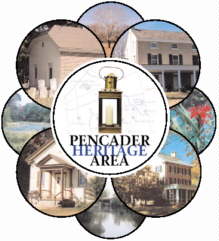 The building is located in the center of Route 40 (Pulaski Highway), facing the west bound traffic, just west of Pencader Presbyterian
Church in the area known as Glasgow. It was built around 1800 to 1810 as two private residences joined with a common wall. The
existing two story brick building is 59 feet long and 20 feet deep. The east end house that was separated in the sales of the property in
the late 1800�s is 21 feet 10 inches wide and for many years had a wood frame section added to the east side that was mentioned in
deeds as a shop or store. The current owner stated that the east house was separate in that it had no passageway to the larger west
house. The framed east end was removed in the late 1900�s.
The building is located in the center of Route 40 (Pulaski Highway), facing the west bound traffic, just west of Pencader Presbyterian
Church in the area known as Glasgow. It was built around 1800 to 1810 as two private residences joined with a common wall. The
existing two story brick building is 59 feet long and 20 feet deep. The east end house that was separated in the sales of the property in
the late 1800�s is 21 feet 10 inches wide and for many years had a wood frame section added to the east side that was mentioned in
deeds as a shop or store. The current owner stated that the east house was separate in that it had no passageway to the larger west
house. The framed east end was removed in the late 1900�s.
The building is sometimes referred to as the Glasgow Bank building but the only reference that can be found is in a book
written by Francis A. Cooch, Little Known History of Newark, Delaware and its Environ�s. In his books he admits to the lack of proof that it
was ever a bank. �Mute testimony to the effect that it was so used, is given in the form of a copper token which was dug up in Mrs.
Frazer's garden about ten years ago. It is about fifteen-sixteenths of an inch in diameter, smooth on the reverse but on the obverse bears
the inscription, "J. Randel, Jr., C. & D Canal," surrounding a wreath enclosing the date "1825." These tokens were given to workers on the C&D Canal, to be exchanged for money. There exists today a tradition, that Randel had cached the sum of $100,000 in or about
the old Banking House.
The early deeds only refer to the building as �Mechanics Row� or a Taylor Shop. Around the time it was built the area we now call
Glasgow was being called Aikentown. Mathew Aiken who�s brother first ran the Tavern called Aiken Tavern, had bought several acres
with the hopes of building a planed village. The New Castle and Frenchtown Turnpike was built in 1812 and passed directly in front
of Mechanics Row. The Turnpike then made a sharp turn south down the west side of the building. The sharp turn was called the
�Devil�s Elbow"
|
